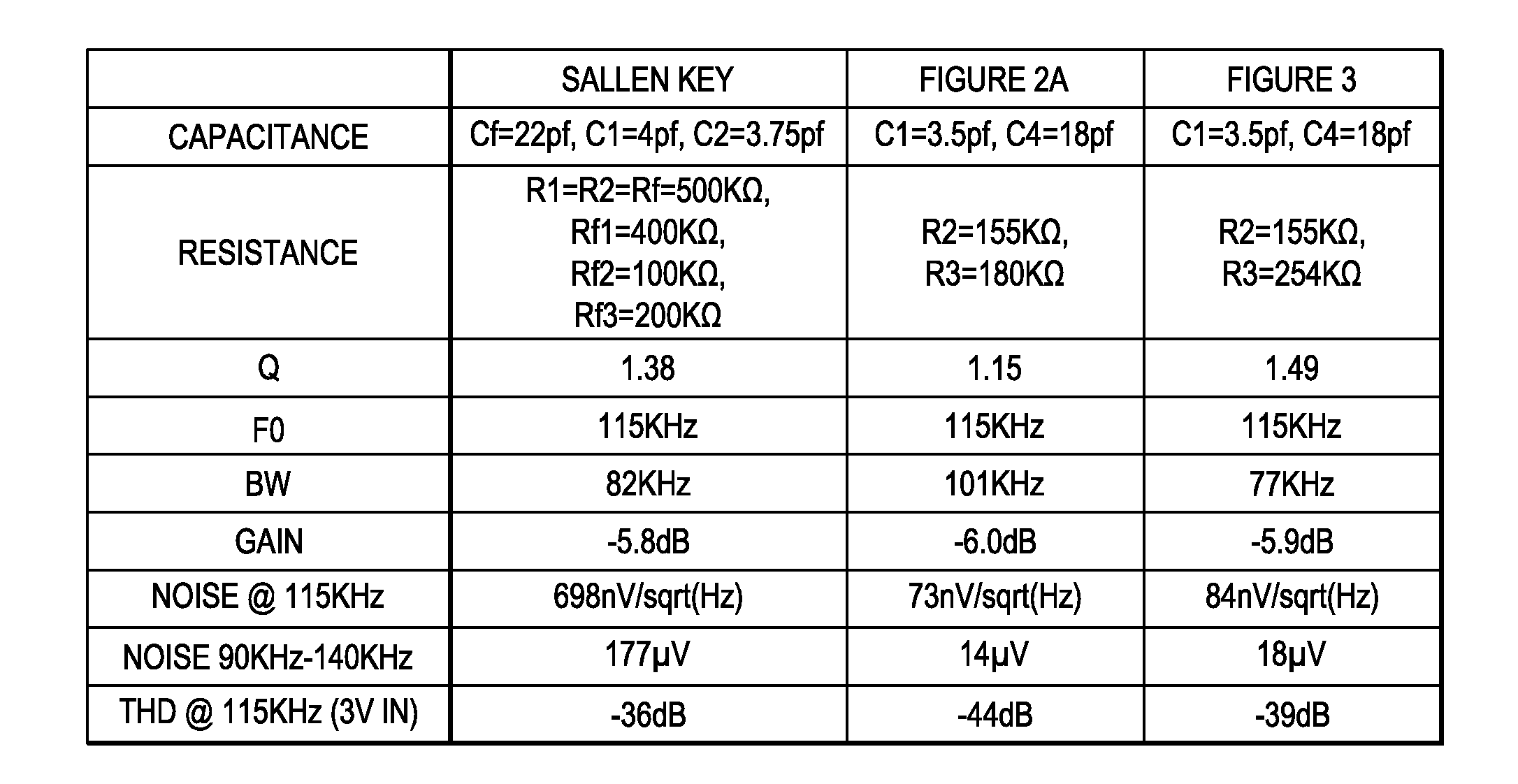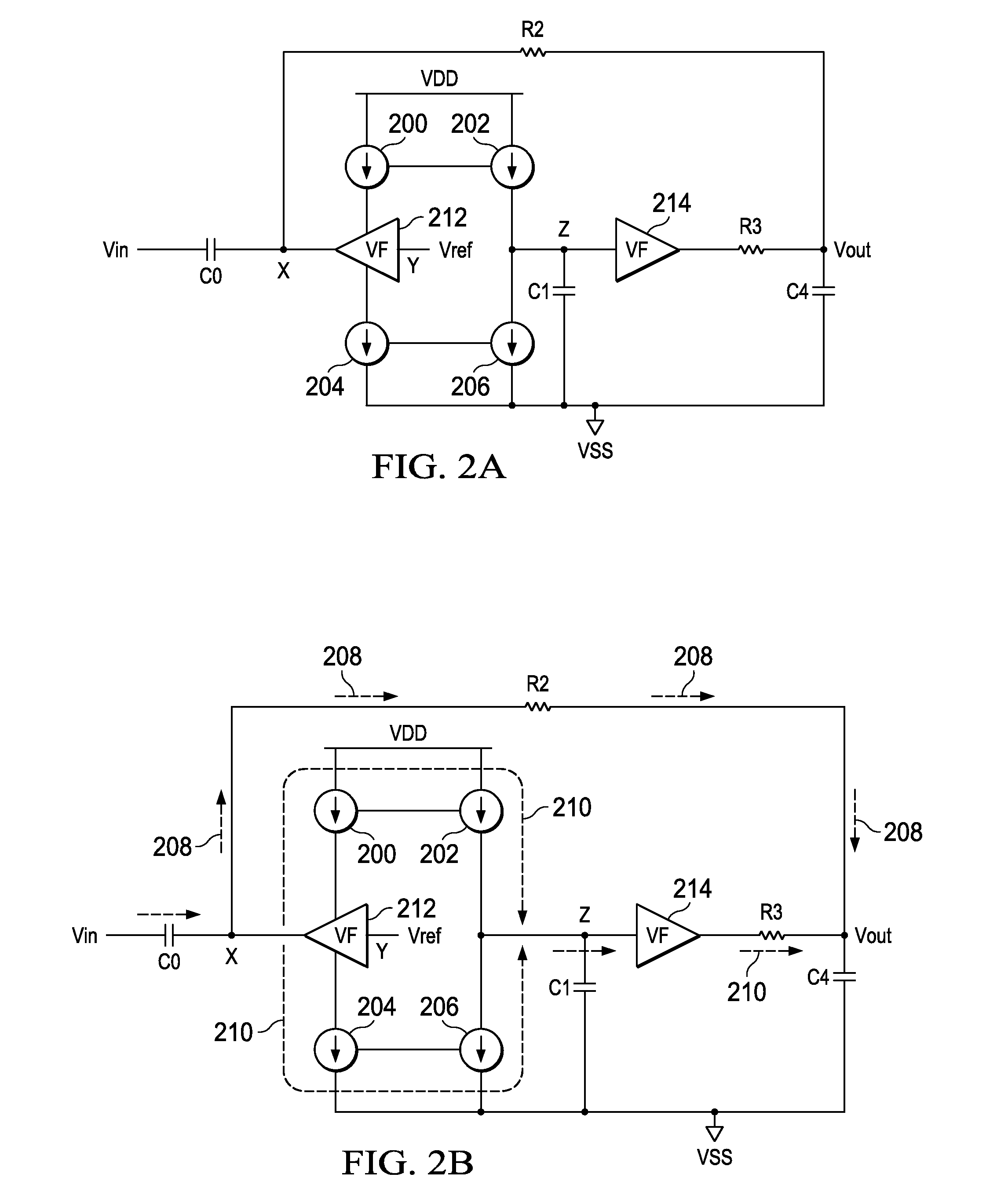Low noise capacitive sensor with integrated bandpass filter
a capacitive sensor and filter technology, applied in the field of low noise, current mode capacitive sensor having an integrated bandpass filter, can solve the problems of significant array noise, significant circuit performance change, and several significant circuit limitations of fig. 1b
- Summary
- Abstract
- Description
- Claims
- Application Information
AI Technical Summary
Benefits of technology
Problems solved by technology
Method used
Image
Examples
second embodiment
[0026]Turning now to FIG. 3, there is a circuit diagram of a bandpass sense amplifier of the present invention. This embodiment is similar to the embodiment of FIG. 2A. However, a second current conveyor circuit including current sources 300 through 306 and voltage follower circuit 308 replace voltage follower 214. Here, the voltage at terminal Z is reproduced at the output terminal of voltage follower 308. The current into the output terminal of voltage follower 308 from current sources 300 and 304 is mirrored into the sense amplifier output terminal at capacitor C4 by current sources 302 and 306. This circuit generates slightly more noise than the circuit of FIG. 2A but less than circuits of the prior art. However, it offers an advantage of increasing sense amplifier gain by either decreasing resistor R3 or increasing resistor R2. A Laplace transform of the transfer function of the bandpass sense amplifier of FIG. 3 is given by equation [12].
H(s)=-sR2C0s2R2R3C1C4+sR3C1+1[12]
[0027]...
first embodiment
[0028]Referring next to FIG. 4A, there is a circuit diagram of a current conveyor circuit that may be used with the bandpass sense amplifiers of FIGS. 2A and 3. The circuit includes p-channel transistors 402 and 404 connected in a current mirror configuration. The circuit further includes n-channel transistors 406 and 408 also connected in a current mirror configuration. Transistors 402 through 408 are equivalent to current sources 200 through 206 (FIGS. 2A and 3), respectively. N-channel transistors 410 and 414 and p-channel transistors 412 and 416 are configured as source followers. Together with current sources 400 and 418, they are equivalent to voltage followers 212 and 214 (FIG. 2A) and 308 (FIG. 3).
[0029]FIG. 4B is a circuit diagram of a second embodiment of a current conveyor circuit that may be used with the bandpass sense amplifiers of FIGS. 2A and 3. The circuit includes p-channel transistors 424 and 426 connected in a current mirror configuration to mirror terminal X cur...
third embodiment
[0030]FIG. 4C is a circuit diagram of a current conveyor circuit that may be used with the bandpass sense amplifiers of FIGS. 2A and 3. The circuit includes p-channel transistors 446 through 452 connected in a cascode current mirror configuration with gates of transistors 450 and 452 receiving reference voltage Vr1. N-channel transistors 454 through 460 are also connected in a cascode current mirror configuration with gates of transistors 454 and 456 receiving reference voltage Vr2. Current source 440 and p-channel transistors 442 and 444 form a differential input stage to the n-channel cascode current mirror circuit. N-channel transistor 462 and p-channel transistor 464 are coupled to receive respective gate reference voltages Vr3 and Vr4. An output stage of the current conveyor circuit is formed by p-channel transistors 466 and 470 and by n-channel transistors 468 and 472.
[0031]In operation, gate to source voltage of p-channel transistor 466 is always the same as gate to source vo...
PUM
 Login to View More
Login to View More Abstract
Description
Claims
Application Information
 Login to View More
Login to View More - R&D
- Intellectual Property
- Life Sciences
- Materials
- Tech Scout
- Unparalleled Data Quality
- Higher Quality Content
- 60% Fewer Hallucinations
Browse by: Latest US Patents, China's latest patents, Technical Efficacy Thesaurus, Application Domain, Technology Topic, Popular Technical Reports.
© 2025 PatSnap. All rights reserved.Legal|Privacy policy|Modern Slavery Act Transparency Statement|Sitemap|About US| Contact US: help@patsnap.com



